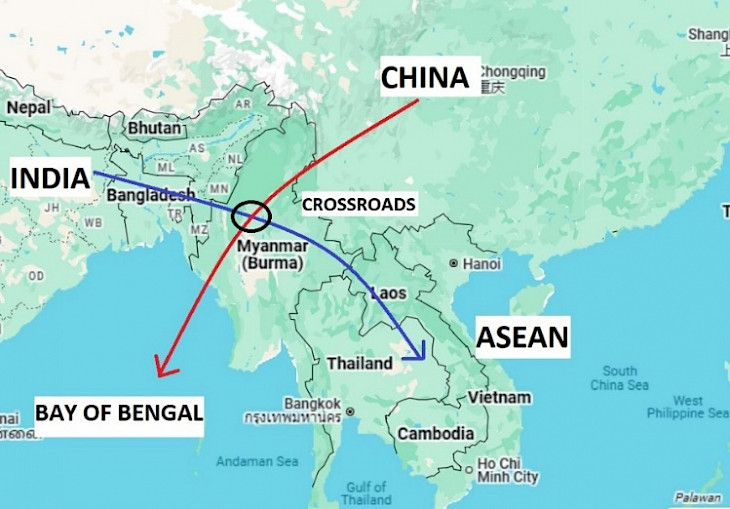Look East, Act East — Now Handle East
Is Southeast Asia slipping through India’s fingers?
India’s relationship with Myanmar is one of historical depth, strategic necessity, and increasing complexity. As China intensifies its footprint in Southeast Asia, and Myanmar slides deeper into political instability following its 2021 military coup, New Delhi must ask itself a pressing question: Are we losing our eastern flank to Beijing?
A Fragile Frontier
The “Look East” and later “Act East” policies were crafted to reconnect India with Southeast Asia, focusing on trade, connectivity, and diplomatic cooperation. Myanmar is at the core of this vision—it is India’s only land gateway to ASEAN and shares a 1,643-kilometer border with our restive Northeast.
But Myanmar is in disarray. Ethnic armed organizations (EAOs) and pro-democracy militias are steadily eroding the military regime’s control. Large swathes of the country are now under rival authorities. Meanwhile, China is not only watching but actively embedding itself.
Why Myanmar Matters to India
Myanmar bridges South and Southeast Asia—geographically, economically, and diplomatically. It is essential to India’s regional outreach through BIMSTEC, and pivotal to infrastructure projects like the India-Myanmar-Thailand Trilateral Highway and the Kaladan Multi-Modal Transit Transport project. Both aim to bypass Bangladesh and the Siliguri Corridor, ensuring direct access to Southeast Asia and the Bay of Bengal.
Myanmar also affects India’s internal stability. Insurgent groups in Northeast India have historically found sanctuary in its jungles. A stable Myanmar is therefore vital for both economic growth and national security.
Enter the Dragon
China views Myanmar through a cold strategic lens: as a corridor to the Bay of Bengal, a source of natural resources, and a node in its “String of Pearls” encirclement of India. Since the 1990s, China has become Myanmar’s top arms supplier, economic investor, and diplomatic shield. It has consistently blocked international action against the junta at the UN Security Council.
Despite civil unrest, Beijing has kept its investments flowing—over $5.6 billion in 2024 alone. From LNG terminals to solar plants and the China-Myanmar Economic Corridor (CMEC), China is building permanent economic leverage. Its flagship Kyaukphyu port project in Rakhine State offers Beijing strategic access to the Indian Ocean, bypassing the vulnerable Malacca Strait.

A Diplomatic Tightrope
India, in contrast, seeks a democratic and stable Myanmar. But it has had to walk a fine line—offering humanitarian aid to Rohingya refugees while simultaneously deporting them, balancing sensitivities between Buddhist-majority Myanmar and Muslim-majority Bangladesh.
India’s approach must be nuanced yet assertive. Engagement cannot depend on waiting for democracy to return; realpolitik demands dialogue with Myanmar’s military rulers to secure border cooperation and push forward infrastructure projects.
At the same time, India must distinguish itself from China’s transactional model. Through civilizational links, shared Buddhist heritage, and people-to-people diplomacy, New Delhi has soft power tools Beijing lacks.
What Must India Do?
To prevent losing strategic ground in Southeast Asia, India must urgently shift from passive observation to active engagement. Here’s how:
- Accelerate Infrastructure Investment: Fast-track key projects like the Trilateral Highway and Kaladan port corridor to deepen economic ties and establish physical presence.
- Promote Religious Tourism and Cultural Diplomacy: Leverage Buddhist heritage to foster people-to-people relations and build goodwill, particularly in Buddhist-majority Myanmar.
- Support Democratic Transition: While maintaining pragmatic ties with the junta, quietly aid civil society groups, education initiatives, and democratic actors for the long term.
- Engage the Military, Practically: Keep communication open with Myanmar’s current power centers to ensure border security and counterinsurgency cooperation.
- Activate BIMSTEC: Use the regional bloc to keep Myanmar engaged in multilateral trade, security, and connectivity frameworks that exclude China.
- Use Soft Power: Ramp up Track II and III diplomacy—academia, youth programs, think tanks, and cultural exchanges—to build a broad-based reservoir of goodwill.
The Window Is Closing
Myanmar is being torn in multiple directions—militarily fractured, economically unstable, and diplomatically isolated. India’s strategic goal should be to keep Myanmar out of China’s exclusive orbit by offering an alternative model of partnership: one grounded in connectivity, mutual respect, and long-term development.
Failing that, we may soon find not only the Chinese at Kyaukphyu, but also their navy in the Bay of Bengal, well within our strategic backyard.
It’s no longer enough to Look East or Act East. India must now Handle East, before China handles it for us.
Col Mohinder Pal Singh, PhD is Director at EGROW Foundation. The views expressed are personal.